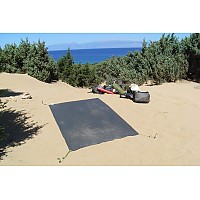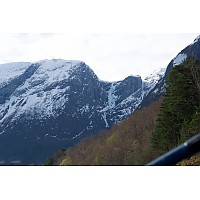Walrus Trekker Tarp
Walrus is no longer in business, and the Trekker Tarp has been discontinued. If you're looking for something new, check out the best tarps and shelters for 2024.
The floor area of the mesh insert measures four feet eight inches wide and seven feet long; thirty-two square feet. The mesh is black, which is visually more transparent than other colors. The urethane coated black nylon floor wraps four inches up the sides. There is a handy pocket for glasses or a light. The mesh insert is attached to the tarp by plastic clips at the two apex ends and by several ring and toggle fittings. The door is BIG and covers over half the front side. The materials seem to emphasize durability over lightweight. Not in a bad way though. The mesh insert is light enough for backpacking( the reason I got it), but it is not so flimsy light that you would worry about tearing it.
The tarp is made of a gray closely spaced ripstop material that is heavier, and seemingly more durable, than the material used for tent flys. It is of a weight commonly found on tarps. The tarp weighs about a pound more than expected but it is a pound of durability. The zippers in this model are covered with an inch wide flap, an improvement over the earlier version. There are Velcro patches at the middle and bottom of the flap to secure it in place. The tarp did not have an instruction sheet included but this is a tarp not a geodome shelter. The attachments for trekking poles, or any pole for that matter, was intuative and worked very well. I tried trekking poles and aluminum tent poles. The trekking poles worked better than the tent poles. The trekking poles had a large diameter, non-slip surface and a bulbous end to be captured in the attachment. The tent poles were less than an inch in diameter, were slick, and did not fasten as securely. The length of the trekking poles was easily and finely adjustable, the tent poles weren't adjustable. I wonder why they called this a 'trekker' tarp?
I purchased the tarp for summer backpacking in northern Minnesota. A spacous, two person mosquito-proof sleeping area and a large awning for protection from rain were the features I wanted. I had been carrying a separate tarp and tent. After checking reviews of tarp/tents the trekker tarp and insert looked promising. I ordered the set. When it arrived I promptly went to the backyard to set up my new home away from home.
Unlike last year's model the tarp's zippers do not zip to the apex. The zipper flap goes to the apex but the zippers stop short, about eight or nine inches below the top. I expected to have the awning open to the apex and stretched out relatively level. This would provide a minimum three feet of headroom. As delivered the tarp opening was only about thirty inches high restricting entry into the insert and providing inadequate headroom under the awning. I could imagine setting the tarp up with the bottom six inches off the ground for ventilation in a rain. If the awning were set up with four foot high poles on the corners then all the rain falling on the awning would flow back down to the awning/tarp gutter and pour into the tent area.
The low zipper height was a fatal flaw for my intended usage. The awning was too low to be usable and awning use in the rain even more compromising. I unsuccessfully checked for the availability of last year's model and ended up reluctantly returning the trekker tarp and insert.
Design: tarp
Sleeps: 2
Ease of Setup: Requires more creativity than an tent
Weight: 6 Lbs.
Price Paid: $147
The Walrus Trekker Tarp is a very well made unit which could provide an excellent alternative to the tent-using traditionalist.
Its A-frame design is a well used one in the great tradition of tentmaking. However, the Walrus departs from tradition in that this one does not come with support poles. The idea is to use trekking poles, dead sticks, canoe paddles or almost whatever is handy. You can also use the two tapes on the outside corners of the tarp to tie it off to some trees instead of using upright poles.
For bug proofing, an optional tent-shaped mesh insert is available. The insert sports a large D-shaped door and a bathtub floor, and is equipped with clips outside the end peaks for attachment to the inside of the tarp.
Ventilation is the obvious strong point, and also happens to be my personal, number one consideration in tent buying.
I really like this shelter, and want terribly for it to work, BUT having said all this, there are some serious problems:
Firstly, I’m a real stickler for a taut setup. This unit has a tough time delivering in this department. It tends to stay kind of saggy if the guy lines do not absolutely sing with tension. Even then, after a short while, the long creases begin to form. Furthermore, the insert also doesn’t seem capable of tautness. The weight of the door zipper alone makes the door side sag inward on top of you.
Next, you can pitch the Trekker (without the insert) as high or low as you like, but when set up, the body of the tarp itself is three feet in depth from the bottom edge to the peaks. The insert itself is about four feet high. So, to use the two in conjunction, your poles of choice can’t be any higher than four feet. That extra foot of space between the ground and the bottom edge of the tarp is what allows for the great ventilation.
Now, Walrus says that for maximum weather proofing you should pitch the tarp flush with the ground. Try this with the insert in place, and you’ve got mesh laying all over you while you try to get comfy. As far as I can see, there isn’t a way to keep the mesh of the insert from doing this, so you’re stuck with this set up if you have, even slightly blowing rain and bugs present at the same time. It sucks. I’ve been there.
We go on. Two of the outside corners of the tarp have zippers up the entire height. Neat. You can guy these out using two more sticks, to form an awning. However, the zippers are not waterproofed in any way, so while closed, they tend to leak some. More of a slow oozing, actually. Not a gushing torrent, just a steady enough drip, drip, drip to get you and your stuff and the floor a little wet. Most of the water will run down the inside of the zipper to the bare ground, but that's little consolation. Kind of makes factory-taped seams sort of irrelevant, doesn’t it? I don’t know— go figure.
The most success I’ve had with this thing, after using it about a dozen times here in the beautiful Catskills, is during the late winter/early spring (before the bug onslaught) without the insert and with no falling precipitation. In other words, conditions in which no shelter at all would be necessary. However, I’ve totally resolved to keep trying and come up with something that works. I just can’t help it: for some reason, I really like this unit and I want it to work. Glutton for punishment, I guess. Besides, I forked over 140 clams for it.
Check out www.walrusgear.com and click on “tarpology” to see the unit.
N'E
Design: tarp
Sleeps: 2
Ease of Setup: With a bit of pratice under my belt, it still takes me about a half hour. Could just be that I'm a dufus.
Weight: 5 lbs
Price Paid: $139
Especially good for kayaking as two support poles are needed to support the tarp and a half a kayak paddle is just the right height (after you dig the paddle in the ground a couple inches). The tarp rests on the poles and is staked out in all directions. Alternatively, without supporting poles, there are hanging tabs from which you can suspend the tarp from a nearby tree (it doesn't have to be right under the tree; they can each pull it out toward the side; this can be very stable).
The tarp covers a large area, which can be changed by raising or lowering the tarp and by staking it out at different places and by zipping or unzipping one side of it creating an awning (two more kayak paddle halbes are useful for this). Four people can play cards under it in a rainstorm easily. At night time, hang the mesh tent under the tarp with the supplied buckles, creating a ~35 sq foot sleeping area and also still tons of room all around for other gear to stay under the tarp. The whole thing is lighter than most tents and is very versatile and is probably perfect for 90 percent of most camping.
Drawbacks: it takes up a fairly big footprint; and while it seemed unlikely that it would be blown down by even high winds if staked out properly, and especially if the guy tabs on top were tied to a tree, the consequences of being blown down would be worse than with most tents. Especially since it is so cheap, definitely worth having.
Design: 2 person hybrid: tarp/tent
Sleeps: 2
Ease of Setup: little harder than average, but never a problem
Price Paid: $150
Simply put, I love it. The overhead roof (awning) is the best feature about it. I don't feel confined in it as in a tent. It's great for 3-seasonal usage. Setup is fairly easy... not as simple as a free-standing tent, but nonetheless a matter of learning how to do it efficiently and properly.
It's a little large for solo backpacking, but it's my shelter of choice until something comes along that's better. I can put all my gear under it and "spread-out". I like stargazing while in my sleeping bag and watching the rain as well. One can also cook under the awning. (I don't have the bug insert.) It was roomy enough for me, a buddy and his yellow lab during an overnighter last November.)
I understand Walrus was purchased by MSR a few years ago and MSR has updated the Trekker Tarp under its banner.
Design: 3 season, non-free standing
Sleeps: 2
Ease of Setup: not as simple as a free standing tent
Weight: 5
Price Paid: $75
Your Review
You May Like
Specs
| Price |
Reviewers Paid: $75.00-$150.00 |







